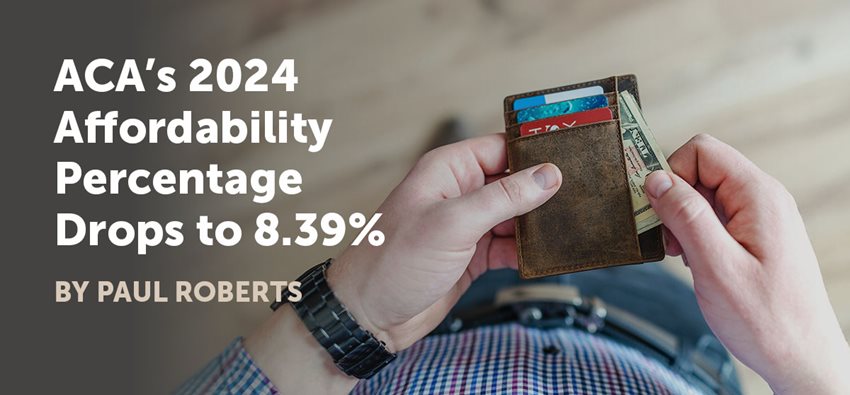ACA’s 2024 Affordability Percentage Drops to 8.39%

The Internal Revenue Service (IRS) recently announced the Affordable Care Act (ACA)’s affordability percentage for the 2024 calendar year; it will be 8.39%.
This is a relatively significant drop from the 2023 affordability percentage, which is 9.12%. The ACA affordability ratio applies to Applicable Large Employers (ALEs), which are subject to the ACA’s employer mandate. ALEs must use the ratio to determine affordability of the health plans offered to eligible full-time employees, in accordance with ACA law. Note that ACA affordability and most mandates do not apply to non-ALE businesses.
As a reminder, ALEs are employers that average 50 or more Full Time and Full Time Equivalent employees as of 1/1 annually – evaluated according to the previous calendar year. Refer to Word & Brown’s ACA Calculators webpage for more information on determining ALE status and other ACA factors for employers.
The ACA affordability percentage also applies to individuals and families seeking Individual and Family Plan (IFP) policies on an individual health insurance Exchange/Marketplace, such as Covered California and Nevada Health Link.
Affordability for Individuals and Families
The ACA makes Premium Tax Credits (PTCs) available to subsidize premiums for eligible individual and family applicants who obtain coverage from a state Exchange/Marketplace. PTCs are based on the cost of the premium for the second lowest-cost IFP Silver Plan on the state exchange, in relation to an applicant’s household income.
Subsidies and PTCs are not available to employees (and may not be available to their family members) if their employer (of any size) makes them an offer of “affordable” job-based coverage, according to ACA standards. If the second lowest cost Silver plan premium for an individual/family applicant exceeds 8.39% of household income in 2024, and the applicant does not have an affordable offer of group coverage from an employer, then premium assistance from the federal government (PTCs) may be available.
Individuals should refer to their state Marketplace’s/Exchange’s websites for more information regarding the costs for IFP coverage and PTC eligibility; each person’s circumstances will be different. PTCs are facilitated entirely by the state’s insurance Exchange/Marketplace website. Additionally, the Kaiser Family Foundation has a PTC subsidy calculator available on its website, available for informational purposes only.
Affordability for Applicable Large Employers (ALEs)
Because employers do not know their employees’ household incomes, the ACA has prescribed three safe harbors from which ALEs may choose when establishing affordability for their employees’ plans.
They may use:
- The employee’s Rate of Pay
- The employee’s W-2 Box-1 income for the corresponding tax year
- The Federal Poverty Level (FPL)
Affordability under the ACA’s employer mandate is based on the employee’s contribution for the lowest-cost ACA-compliant plan offered by the ALE. It does not consider the cost to cover spouses or dependents; however, the law does require ALEs to offer dependent coverage (at any cost) to eligible full-time employees’ dependents. It also does not consider the plan the employee enrolls in; it is always based on the lowest-cost ACA compliant plan offered to the employee by the ALE.
While the ACA percentage applies on a calendar year basis for subsidies in the IFP market, the ACA percentage applies on a plan year basis for ALEs. When the employer’s plan is established or renews in 2024, the new percentage begins to apply for the entire plan year. For example, a group with a 12/1 effective date will use the 9.12% affordability percentage beginning December 1, 2023, all the way through November 30, 2024. Then, the ALE will use the 2024 percentage beginning on December 1, 2024, and so forth.
Minimum Wage Changes
State minimum wage in both California and Nevada is increasing in 2024. In California, the state minimum wage rises to $16/hour effective 1/1/2024. In Nevada, the state minimum wage rises to $12/hour beginning 7/1/2024.
This change will require some employers to carefully evaluate their minimum earners’ wages and ACA affordability standards to satisfy compliance efforts.
Furthermore, note that many municipalities (especially in California) have minimum wage requirements that exceed these state requirements.
Tax and Payroll Counsel Recommended
As the ACA law and ACA IRS reporting are ultimately IRS and tax-related matters, it is imperative to work with a tax professional for compliance with ACA laws and IRS regulations, according to an employer’s own specific circumstances.
Lastly, employers of all sizes should also consult payroll and/or employment law council to ensure full compliance with all applicable laws related to minimum wage and ACA premium affordability for ALEs.
Most Recent Articles
Technology
Technology

